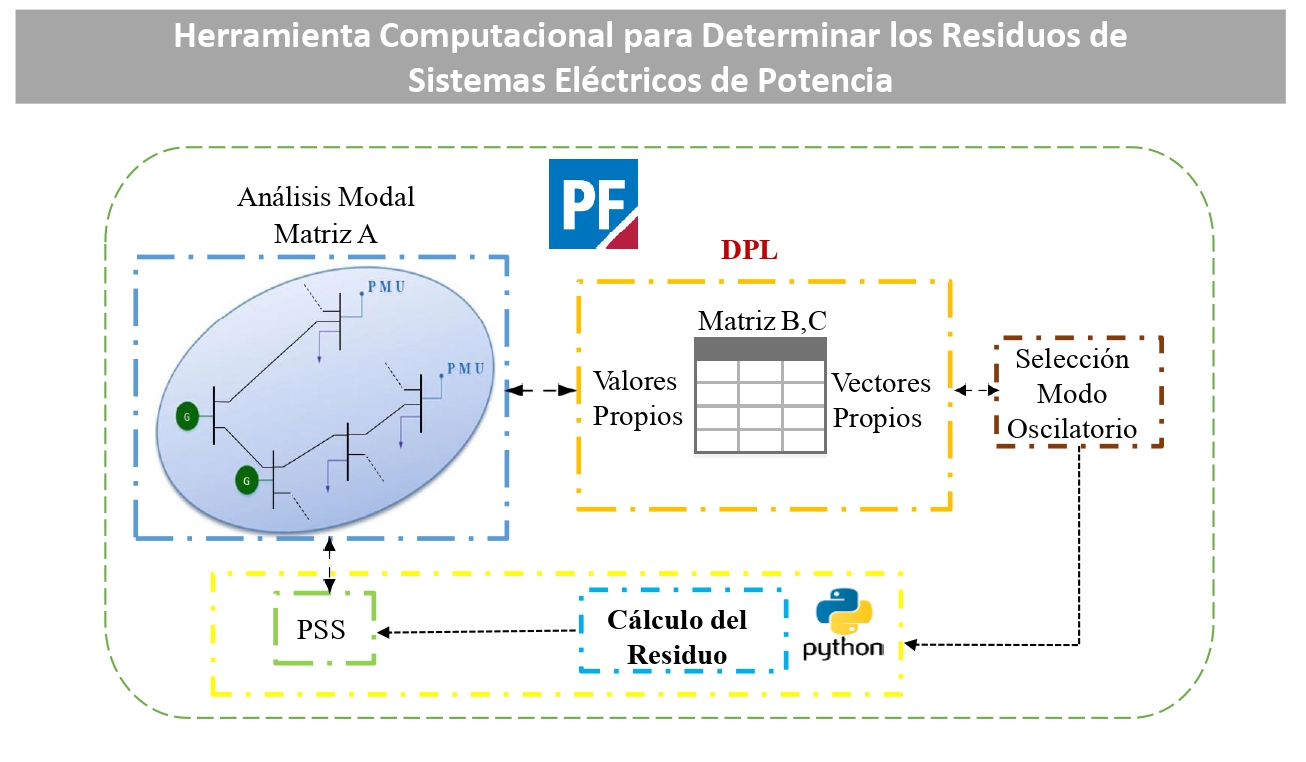Computational Tool to Determine the Residues of Electrical Power Systems
##plugins.themes.bootstrap3.article.main##
Abstract
This paper presents the development of a tool to calculate the residue of the critical oscillation modes for an electrical system obtained through the DIgSILENs PowerFactory modal analysis tool. This problem is essential in current electrical systems that are characterized by operating their elements at the limit, and if these oscillations are not adequately damped, they can cause generator failures by reducing their level of stability, making the system vulnerable. PowerFactory is an engineering tool to analyze electrical systems, widely used in industry and research. This software has its own programming language, DIgSILENT Programming Language (DPL), providing the capability to process variables of interest from the modal analysis, which can be used in other system devices, such as power system stabilizers (PSS). The residue of the critical oscillation modes can be calculated by programming the variables of interest. Consequently, the calculation of residue requires the processing of the state matrix A provided directly by PowerFactory, whereas it is possible to construct the matrices of the input variables B and output variables C, respectively, by means of DPL programming for different operating scenarios of the electrical power system. The calculation methodology has been applied to electrical systems from the literature specialized in oscillatory stability. The tool is applied to observe the dynamics of the oscillation modes both with and without PSS, the latter being tuned by the calculated residues.
##plugins.themes.revistapolitecnica.stadistisDownloadTitle##
Downloads
Article Details
References
Cañizares, C., Fernandes, T., Geraldi, E., Gerin-Lajoie, L., Gibbard, M., Hiskens, I., Kersulis, J., Kuiava, R., Lima, L., DeMarco, F., Martins, N., Pal, B. C., Piardi, A., Ramos, R., Dos Santos, J., Silva, D., Singh, A., Tamimi, B. & Vowles, D. (2017). Benchmark Models for the Analysis and Control of Small-Signal Oscillatory Dynamics in Power Systems. IEEE Transactions on Power Systems, 32(1), 715-722. http://doi.org/10.1109/TPWRS.2016.2561263
Chow, J., & Sanchez, J. (2020). Power System Modeling, Computation and Control. IEEE Press. DIgSILENT (2022).PowerFactory User’s Manual Version 2022 DIgSILENT GmbH. Gomaringen.
Edrah, M., Lo, K., & Anaya-Lara, O. (2016). Reactive power control of DFIG wind turbines for power oscillation damping under a wide range of operating conditions. IET Generation, Transmission & Distribution, 10(15), 3777-3785. http://doi.org/10.1049/iet-gtd.2016.0132
Kundur, P. (1974).Power System Stability and Control. McGraw Hill.
Mondal, D., Chakrabarti, A., & Sengupta, A. (2020).Power System Small Signal Stability and Control. Elsevier Academic Press. Oscullo, J., & Gallardo, C. (2020a). Residue Method Evaluation for the Location of PSS with Sliding Mode Control and
Fuzzy for Power Electromechanical Oscillation Damping Control. IEEE Latin America Transactions, 18(1), 24-31. https://doi.org/10.1109/TLA.2020.9049458
Oscullo, J., & Gallardo, C. (2020b). Adaptive tuning of power system stabilizer using a damping control strategy considering stochastic time delay. IEEE Access, 8(1), 1-11. http://doi.org/10.1109/ACCESS.2020.3004067
Pizarro-Galvez, S., Pulgar-Painemal, H., & Hinojosa-Mateus, V. (2014).Chapter 10: Parameterized Modal Analysis Using DIgSILENT Programming Language. PowerFactory Applications for Power System Analysis, 1(1), 221-248. http://doi.org/10.1007/978-3-319-12958-7_10
Pota, H. (2018).The Essentials of Power System Dynamics and Control. Springer Nature.
Rohit, C., Yadav, K., & Darji, P. (2021). Optimal Placement of SVC using Residue Technique and Coordination with PSS for Damping Inter-Area Oscillations. 31st Australasian Universities Power Engineering Conference (AUPEC), 1(1), 21507508. http://doi.org/10.1109/AUPEC52110.2021.9597791
Silva-Saravia, H., Pulgar-Painemal, H., & Wang, Y. (2018).Chapter 7: Determining Wide-Area Signals and Locations of Regulating Device to Damp Inter-Area Oscillations Through Eigenvalue Sensitivity Analysis Using DIgSILENT Programming Language. Advanced Smart Grid Functionalities Based on PowerFactory, 1(1), 153-179. http://doi.org/10.1007/978-3-319-50532-9_7




